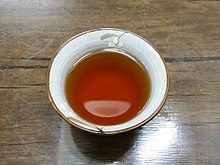Sicklepod tea
 | |
| Type | Tea |
|---|---|
| Country of origin | Korea |
| Ingredients | Sicklepod seeds |
| Korean name | |
| Hangul | 결명자차 |
|---|---|
| Hanja | 決明子茶 |
| Revised Romanization | gyeolmyeongja-cha |
| McCune–Reischauer | kyŏlmyŏngja-ch'a |
| IPA | [kjʌl.mjʌŋ.dʑa.tɕʰa] |
Gyeolmyeongja-cha (Korean: 결명자차; Hanja: 決明子茶) or sicklepod tea is a tea made from roasted (but not ground) seeds of Senna (formerly Cassia) spp., especially S. obtusifolia and S. tora.
Ingredient
[edit]The roasted seeds of gyeolmyeongja (결명자; 決明子) are used,[1] this being the Korean name for cassia seeds (Chinese: jué míng zǐ, Japanese: ketsumeishi),[2] i.e., the seeds of the Cassia (Senna) genus of leguminous plants, particularly S. obtusifolia and S. tora.[2][3][4]
One source however identifies the ingredient as a plant related to Cassia nomame,[5] synonymous with Chamaecrista nomame.[6]
Preparation
[edit]About 20–30 grams (0.71–1.06 oz) of dried sicklepod seeds are roasted, and decocted in around 600 millilitres (21 imp fl oz; 20 US fl oz) of water.[7] Sugar or honey is not added.[7]
Use
[edit]The name gyeolmyeongja means "the seed that brightens the eyes".[8] Gyeolmyeongja-cha is also used as herbal medicine.
Similar beverages
[edit]In Japan, the habu-cha originally referred to an infusion of roasted cassia seeds brewed from habusō or S. occidentalis, but the habu-cha now commercially sold is usually made from S. obtusifolia.[9][10]
The aforementioned Chamaecrista nomame is called kawara-ketsumei (カワラケツメイ, literally 'riverbank sicklepod') in Japan, and its leaves and seeds into hot beverages called mame-cha (豆茶) or hama-cha (浜茶), especially in southern regions such as Kyushu.[11][12]
Cassia seed tea is consumed not only in East Asia (China, Japan, Korea), but in Southeast Asia (Thailand, etc.) as well.[13] In Thailand, S. ora is called chum het thai (ชุมเห็ดไทย);[13][14] the roasted seeds are used as diuretic, and the seeds or leaves as purgative.[13][15]
Cassia tora seeds which are roasted and ground have been noticed as ersatz coffee in India, and C. occidentali also brewed into what used to be called "negro coffee" in Africa, South America, and the West Indies.[16][13] The leaves have also been used for substitute coffee in India, though unflavorful.[13]
See also
[edit]References
[edit]- ^ "gyeolmyeongja-cha" 결명자차. Standard Korean Language Dictionary (in Korean). National Institute of Korean Language. Archived from the original on 2018-07-09. Retrieved 28 January 2017.
- ^ a b Wang, Yuan; Sheir, Warren; Ono, Mika (2010). Ancient Wisdom, Modern Kitchen: Recipes from the East for Health, Healing, and Long Life. Hachette Books. p. 23. ISBN 9780738214054.
- ^ International Food Information Service (2009). IFIS Dictionary of Food Science and Technology (2 ed.). John Wiley & Sons. p. 79. ISBN 9781405187404.
- ^ Chinese Medicine Quality Standardization Research Project Team, National Institute of Food and Drug Safety Evaluation [in Korean] (2018-07-12), Gyeolmyeongja 결명자 (決明子) [Cassiae Semen]
- ^ The Korea Foundation (2014). Korean Food Guide. Korea Foundation. ISBN 9791156040804.
- ^ Bisby, Frank (1994). Phytochemical Dictionary of the Leguminosae. CRC Press. p. 765. ISBN 9780412397707.
- ^ a b 김, 상현. "gyeolmyeongja-cha" 결명자차. Encyclopedia of Korean Culture (in Korean). Academy of Korean Studies. Retrieved 9 May 2017.
- ^ Lee, Yeongsu (March 17, 2012). "Food that protects people from yellow dust(황사에 도움이 되는 음식)". Retrieved 22 March 2018.
- ^ Okada, Minoru; Wada, Hiroshi (2002). Shintei genshoku makino wakan yakusō daizukan 新訂原色牧野和漢薬草大圖鑑 [New edition of Makino's great encyclopedia of Japanese and Chinese medicinal herbs in original color] (in Japanese). Hokuryukan. pp. 204, 205. ISBN 9784832608108.
- ^ Tōhō University, Yakugakubu fuzoku yakuyō shokubutsuen (medicinal herbarium attached to pharmacology dept.) (May 2019). "Ebsisugusa" エビスグサ. Yakuyō shokubutsuen mihon-en 薬用植物園 見本園 (in Japanese). Retrieved 2020-12-19.
- ^ Ochiai, Yukino (2013-12-24). "Chagai no cha: shikōhin to iyakuhin no hazama de" 茶外の茶 : 嗜好品と医薬品のはざまで [History and current status of herbal tea for both refreshment and health benefits]. The memoirs of the Institute for Oriental Culture. 164 (164): 89–87. doi:10.15083/00026847. (in Japanese, with English abstract)
- ^ Katanoda, Itsurō (1999). Ryūkyū ko/noyama no hana From Amai: taiyō no okurimono 琉球弧・野山の花 From Amami: 太陽の贈り物 [Ryukyu Arc/flowers of the fields and mountains; From Amami: gift of the sun] (in Japanese). Nanposhinsha. p. 59. ISBN 9784931376212.
- ^ a b c d e Kijima, Masao (1969). "Tai koku shōyaku no kōsatsu III" <報告>タイ国生薬の考察 III [Observations III on herbal medicine in Thailand]. Japanese Journal of Southeast Asian Studies (in Japanese). 7 (1): 78–79. hdl:2433/55564.
- ^ Mulholland, Jean (1989). Herbal Medicine in Paediatrics: Translation of a Thai Book of Genesis. Faculty of Asian Studies, Australian National University. p. 324. ISBN 9780731507917.
- ^ Mulholland, Jean (1989). Medicine, Magic and Evil Spirits: Study of a Text on Thai Traditional Paediatrics. Australian National University. p. 287. ISBN 9780731500161.
- ^ Watt, George (1889). A Dictionary of the Economic Products of India: Cabbage to Cyperus. Superintendent of Government Printing. p. 226.
